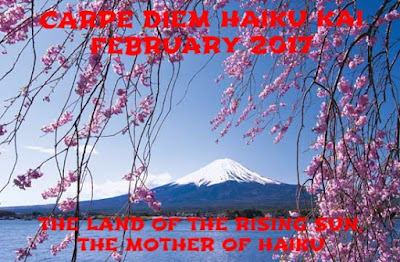Dear Haijin, visitors and travelers,
First this: At the left side of our Kai you can find the link to the download of "Only Footprints" by Candy, the latest exclusive CDHK e-book. Candy has created a wonderful e-book and I hope, as the editor of it, that you all will like it as much as I liked creating it.
Maybe you have noticed it already, but I haven't published our new episode of our new special feature "Namasté", but that had to do with time. After our regular episode I will also publish our new "Namasté" episode.
We are on a journey "criss-cross" through Japan the native country of haiku and today I love to travel on to the island of Shikoku. Maybe you can remember our pilgrimage along the 88 temples on this island. The Shikoku pilgrimage is a once in a lifetime to do pilgrimage of Buddhist, as is the Hadj for the Muslim.
The Shikoku pilgrimage is originated by Kobo Daishi (also know as Kukai), the founder of the Shingon sect of Buddhism, and it brings you along the 88 temples on Shikoku island. During some circumstances that take a bit of time from me I have taken the easy way today. I will reproduce the first episode of our Shikoku pilgrimage back in 2014 here again. I hope you don't "hate" me for that choice (smiles).
 |
| Sakura Temple on Shikoku Island |
Shikoku is one of the four main islands (Hokkaido, Honshu, Shikoku, and Kyushu) that make up Japan. The island is located between the Seto Inland Sea and the Pacific Ocean. There are four prefectures located there: Tokushima, Kagawa, Ehime, and Kochi. Tokushima has close political, economic, and cultural ties to the Kansai region of Honshu, which includes cities like Osaka and Kyoto. In recent years, three bridges spanning the Seto Inland Sea have created land routes between Honshu and Shikoku. One connects Kobe to the city of Naruto in Tokushima via Awaji Island on the Kobe-Awaji-Naruto Expressway (the Akashi Kaikyo Bridge). The second route connects Okayama Prefecture's Hayashima with the city of Sakaide in Kagawa via the Seto-Chuo Expressway (the six Seto-Ohashi Bridges; this route also features a rail line). The third connects Hiroshima's Onomichi with the city of Imabari in Ehime via the Nishi-Seto Expressway (the three Kurushima-Kaikyo Bridges; this route is also accessible on foot or by bicycle). With the construction of these routes, travel between Honshu and Shikoku via expressway and railway (Seto-Ohashi Bridge) has become more convenient than ever before.
 |
| Iya Kazurabashi Bridge, Takushima Prefecture Shikoku |
There are plenty of wild and natural spots, scenic and historic places, and traditional festivals.
Naoshima, where nature and contemporary art coexist, Mt. Ishizuchi, one of the highest peaks in West Japan and a popular destination for hikers, the Naruto whirlpools, one of the largest whirlpools in the world, the thatched traditional house known as Chiiori which is located in the Iya valley, known as one of the three most remote places in Japan and the place where the defeated Heike warriors took refuge at the end of the 12th century, the Shimanto River which is called Japan's last clear stream where local people enjoy river recreation., Kompira Shrine which is home to the god of the sea, Dogo Hot Spring which is one of Japan's oldest hot springs with several thousand years of history, Awa Odori summer festival which attracts 1.3 million people annually, Kochi prefecture's summer Yosakoi festival which attracts 1 million people, Kochi's outdoor Sunday Market which is one of Japan's largest, and many many other attractions are what make up Shikoku.
 |
| Kan Henro, tradiotnal pilgrim clothing for the Shikoku pilgrimage |
dedicated to the Path of Enlightenment
four countries as one
© Chèvrefeuille
Shikoku Island knows four prefectures and that's reflected in it's name that means "four countries". Back in 2014 I enjoyed this Shikoku pilgrimage very much and I hope you all have nice memories at it too. By the way if you would like to read those episodes again or for the first time? Scroll down in the menu at right side of our Kai and click on the year 2014, February and March. Than you can "re-do" that pilgrimage again or discover the beauty of that pilgrimage.
pilgrims chanting
the Heart Sutra to honor Kukai -
cry of a Vulture
breaks through the serene temple -
pilgrims chanting
© Chèvrefeuille
To enlighten the meaning of the above tanka I have a short explanation for you about this tanka.
Ryozenji Temple, the first temple of the Shikoku pilgrimage, is also known as "Vulture Peak" which refers to one of the sermons the Buddha once gave on a mountain with the same name. It was on that mountain that Buddha started with his religion and wrote the Heart-Sutra and e.g. the Lotus-Sutra.
This episode is NOW OPEN for your submissions and will remain open until February 16th at noon (CET). I will try to publish our next episode later on.

another great post to make my little gray cells to working.
ReplyDelete